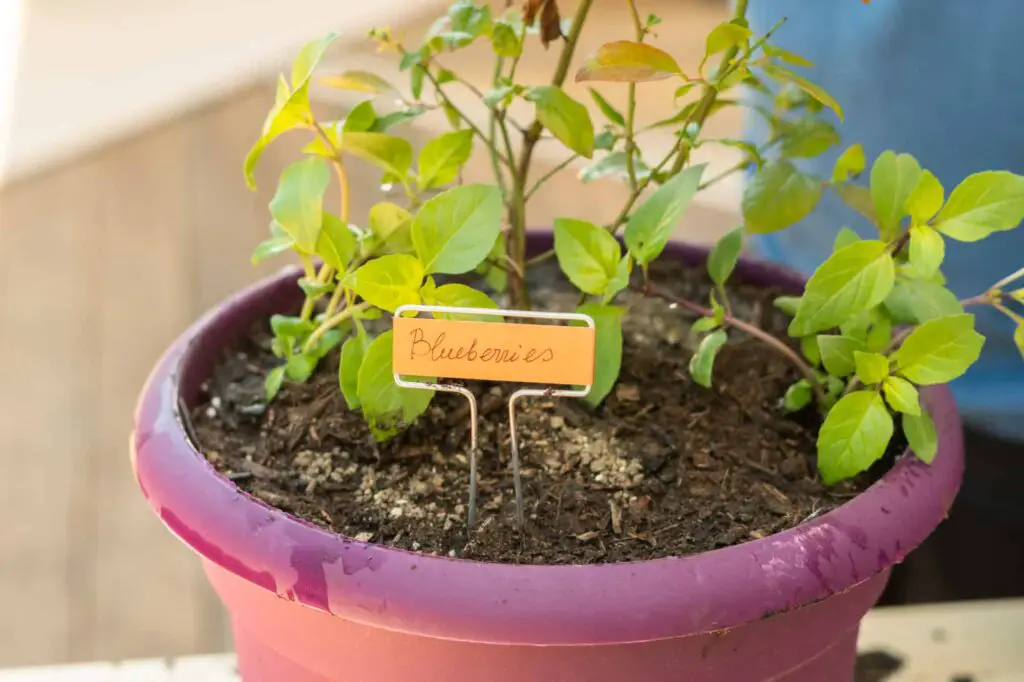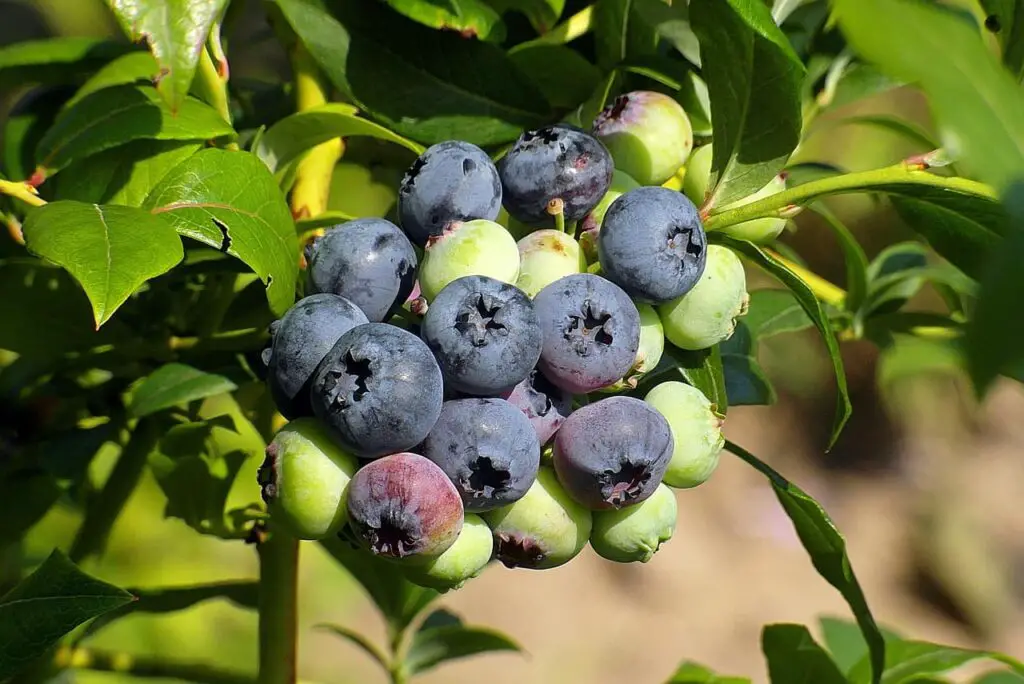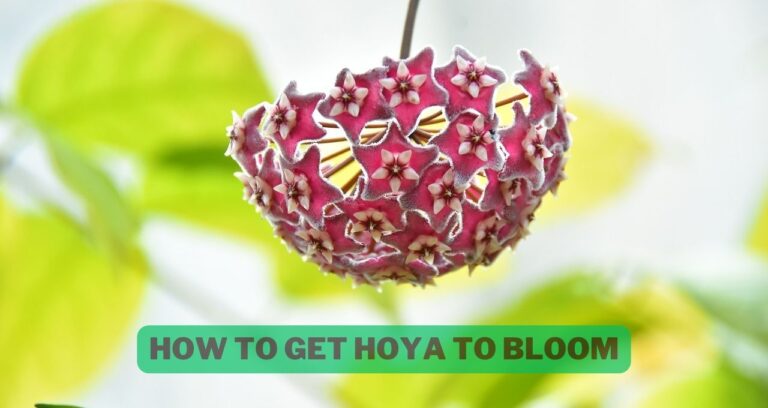Can Blueberry Bushes Grow In Pots: Easy How-To Guide
Are you a fan of the delightful flavor of fresh blueberries but don’t have enough room for a full garden? Growing blueberry bushes in pots might be the solution for you. This lets you relish juicy, fresh blueberries in the comfort of your home and enhances your area’s visual charm. But we need clarification about can blueberry bushes grow in pots.
We try to give you proper guilds on growing blueberry bushes in pots, from selecting the container size to caring for your plants and identifying common pests and diseases. We will also recommend the best blueberry varieties suited for container gardening.
Can Blueberry Bushes Grow in Pots?

Yes, blueberry bushes can grow in pots. Blueberry bushes can grow in pots if the container is large enough. Blueberries have shallow roots but still need ample space to spread and grow.
But, If you expect to harvest blueberries after the first year of planting them in your pots. It will not be possible.
Potted blueberry bushes usually take about five years to produce a full crop. If you want to repot your plants, Transplant them during late summer or early fall to give their roots ample time to grow before winter arrives.
Containers
When growing blueberry bushes in pots, selecting the right container is important. Choose a container with a depth of at least 16-18 inches and a diameter ranging from 18 to 24 inches. This will provide enough space for the roots to grow and develop.
Choosing a container made of durable such as terracotta or ceramic is also important. Avoid using containers made of metal since they may rapidly heat up in the sun and cause harm to the roots of your plants.
Choose a container at the bottom of the pot with several drainage holes so water can flow out. This prevents soil from becoming overly moist, which may cause root rot. Adding some gravel or stones layer at the container’s bottom improves drainage.
Read More: Are Terracotta Pots Good For Plants?
Selecting a Planting Site
Selecting the appropriate site for cultivating blueberry bushes in containers is very impotent. Avoid areas with heavy foot traffic or where water tends to collect. Leave at least 1 or 3 feet of space between each shrub because they may get enough light and continue to develop.
Light
Blueberry bushes need full sun to grow and produce fruit. Place your pots in an area that receives at least 6 hours of direct sunlight daily. It helps to ensure optimal growth.
If you don’t have an appropriate place. Grow lights are an effective addition to the natural sunshine. Provide shade throughout the day if you live in an area with high temperatures. It delays the process of the soil drying out too much.
During the growing season, blueberry bushes must get full sun every day. Remember not to place containers near reflective surfaces that intensify sunlight as they may cause heat stress.
Watering Routine

Blueberries need consistent moisture to thrive, especially when growing in pots. Always give your blueberry plants consistent and enough water.
Maintain moist soil that is not waterlogged at all costs. Also, don’t let the soil get entirely dry between watering. This may lead to stress and affect fruit production.
Applying mulch around the bushes is an effective way to maintain soil moisture and inhibit the growth of unwanted weeds. Use a soil moisture meter to decide the moisture level in the soil and water. Avoid misting leaves and flowers, as doing so could foster fungal diseases. Cover the top with pine needles, conifer wood chips, or bark to maintain soil moisture throughout the winter.
Fertilizer
Feed your blueberry bushes during the early stages of growth. It will result in lush foliage but sparse fruit production.
Once the berries plant starts growing. Apply a well-balanced fertilizer with a high proportion of nitrogen and a low proportion of potassium. Avoid harmful chemicals that may damage your plants.
Blueberries grow best in acidic soil. Use fertilizers formulated for such soil conditions. It helps maintain the pH level of the potting mix with peat moss or pine bark added to it.
Once or twice a year, use a slow-release organic fertilizer, such as compost or aged manure. But, only use balanced plant food products without high nitrogen, phosphorus, or potassium (N/P/K).
These can cause blossom end rot in the plants. Also, over-fertilizing can harm your crops. as excessive acidity can cause root burns and damage the plant’s growth.
Pollination
Pollination is important for fruit production in blueberry bushes. Even those grown in pots, while some varieties are self-pollinating. Having at least two different varieties of blueberry bushes is still ideal for increasing the chances of pollination.
It’s ideal if you grow flowers near blueberry plants. It also invites pollinators like butterflies and bees or uses a natural bee attractant spray.
Additionally, shaking the branches during bloom time. It helps distribute pollen and increases the likelihood of a bountiful harvest.
Soil
Choosing the correct potting soil for blueberry in pots plays a crucial role. Going for a high-quality potting mix designed for acid-loving plants is ideal. Buy a soil blend prepared for plants like azaleas or rhododendrons, as it would be perfect for cultivating blueberries. You can find that soil at most plant nurseries and gardening centers.
You can also make your own by mixing peat moss, perlite, and vermiculite. It’s best to steer clear of regular garden soil when planting blueberries. It may contain high alkaline levels unsuitable for their growth. Regular soil testing and change are essential to maintain optimal conditions with a potting soil pH of 4.5-5.5 for your blueberry shrub.
Read More:- How to keep dogs out of potted plants | 6 Easy Tips
Temperature and Humidity
Blueberry bushes prefer cool temperatures and high humidity.
Place in a location that receives partial sun, with temperatures ranging from 60-70 degrees Fahrenheit. During hotter months, you can mist the leaves to maintain high humidity.
To regulate temperature and humidity levels. Use a greenhouse or place the pots in a shaded area during hot weather.
Pruning
To promote the healthy growth of potted blueberry plants. It is important to prune them correctly. Pruning must be done in late winter or early spring before new growth starts.
Remove any dead, damaged, or diseased branches. After that, thin down overcrowded areas to optimize air circulation and enable more light to enter.
When pruning, aim to maintain a balanced shape for your blueberry bush. Cutting down long, leggy stems and promoting new growth from the base is required. You can also remove low-hanging branches to make harvesting easier. Transferring it into a larger container may be necessary as the bush grows.
Choosing the Right Blueberry Variety
There are many varieties of blueberries. However, not all are suitable for growing in container gardening. When choosing a blueberry variety, look for ones known to be compact and bushy.
Such as ‘Top Hat’, ‘Northsky’, or ‘Sunshine Blue’.
These varieties are perfect for container gardening and will grow only a little large or tall. Choose a variety suitable for your climate.

Common Pests and Diseases for Blueberries in Pots
Knowing the common pests and diseases that can impact Blueberries is important.
- Pests like Small spider mites can damage leaves, reducing growth and fruit yield.
- Blueberry maggots lay their eggs on the fruit, causing it to become inedible.
- Anthracnose is a fungal disease leading to brown leaf spots and defoliation. It also is problematic for potted blueberries.
- Phytophthora root rot is a soil-borne disease. That can cause root rot in blueberries grown in containers.
So check your plants regularly for signs of pests or diseases. Use organic pest control methods like netting or burlap to prevent cross-contamination.
Prevention and Treatment of Pests
To protect blueberry bushes grown in pots from pests.
Keeping the area around the pot clean and removing debris or fallen leaves is essential.
Insecticidal soaps and neem oil sprays are effective organic pest control methods. For treating infestations on blueberry plants.
Aphids, fruit flies, and mites can damage your blueberries. So follow these prevention measures for a bountiful harvest season.
Proper watering techniques with good drainage can help prevent root rot. At the same time, regular pruning of affected branches or using fungicides helps combat these common pests and diseases.
Choosing disease-resistant varieties and maintaining healthy soil is important. Keep an eye out for disease symptoms l and take quick action to remove them or use fungicides for treatment.
Types of Blueberries
- Highbush Blueberries: Highbush blueberries (Vaccinium corymbosum) are the most common and cultivated. They produce large, sweet berries in different cultivars, such as ‘Bluecrop,’ ‘Jersey,’ and ‘Duke.’
- Lowbush Blueberries: Lowbush blueberries (Vaccinium angustifolium) are smaller and grow in spreading clusters near the ground. The flavor of these fruits is much stronger, making them a popular choice for baking and creating jams.
- Rabbiteye Blueberries: Rabbiteye blueberries (Vaccinium ashei) originate from the southeastern region of the United States. They are known for their high tolerance to heat and are often grown in warmer climates. Rabbiteye blueberries have a tart flavor.
- Southern Highbush Blueberries: Southern highbush blueberries are hybrids. That combines the characteristics of highbush and rabbiteye varieties. These plants thrive in areas with mild winters and hot summers.
- Half-High Blueberries: Half-high blueberries are hybrids between highbush and lowbush varieties. They are small and appropriate for smaller gardens and containers. These berries are medium-sized and tasty.
- Wild Blueberries: Wild blueberries (Vaccinium angustifolium) grow in acidic soils and are smaller than cultivated varieties.
- Dwarf Blueberries: Dwarf blueberry varieties are bred to stay compact, making them ideal for growing in containers or small spaces. They produce smaller berries but are often prized for their ornamental value.
- Northern Highbush Blueberries: Northern highbush blueberries are cultivars adapted to cooler climates. A specific number of cold hours during the winter is necessary to produce a bountiful harvest.
Read More: How to Prune Queen of the Night Plant : Like a Pro

Can blueberry plants survive winter in pots?
Blueberry plants in pots can survive winter if they are cared for. Select a type suitable for your area’s weather conditions and offer adequate insulation and protection against frost. Move the pots to a sheltered area during the coldest months, or wrap them in burlap to protect them from harsh winds.
Can blueberry plants survive frost?
To protect blueberry plants from frost damage during flowering and fruiting. Choose a cold-tolerant variety for your climate. Use frost cloth to cover the plants on cold nights to ensure sufficient protection.
Can You Grow Strawberries With Blueberries?
Yes, you can grow strawberries with blueberries. Both plants prefer acidic soil and similar growing conditions, making them good companions in a container garden.
How long do blueberries in pots take to grow?
Blueberries grown in pots can take 2-3 years to produce fruit. But, growth rates vary depending on the blueberry variety, pot size, and environmental factors like sunlight and water. Regular pruning and fertilizing can also help promote healthy growth and earlier fruiting.
Conclusion
So you can blueberry bushes grow in pots if you give them the attention and care they need. They are capable of producing a large crop on your patio or balcony. The experience of growing blueberries in containers as a gardener is very satisfactory. Not only do blueberry bushes add a vibrant touch to your garden, but they can also thrive in pots.
Source: – https://extension.umn.edu/fruit/growing-blueberries-home-garden





